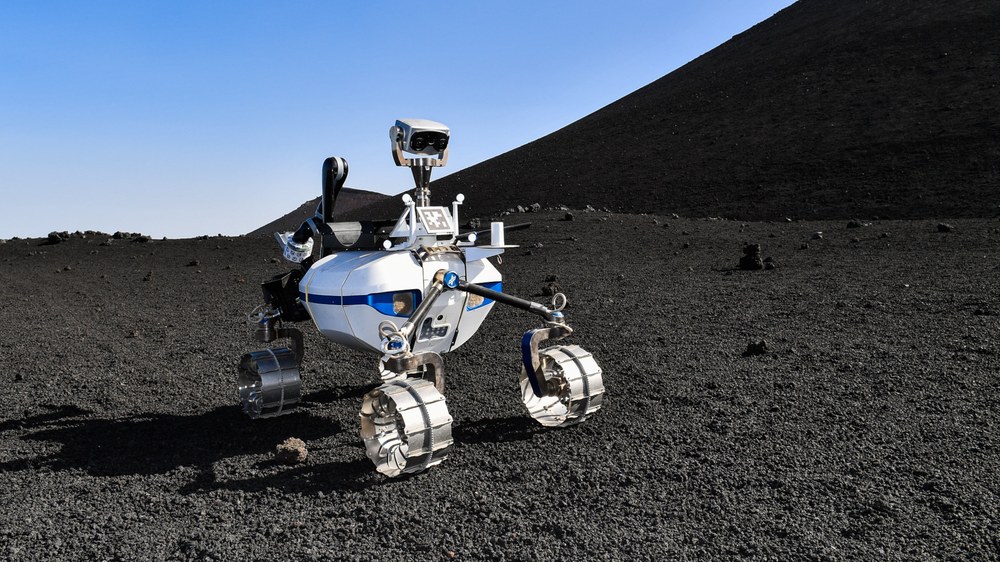The DLR components of the ARCHES space-analogue demonstration mission



The scout – ARDEA
The micro-aerial Vehicle ARDEA, which was developed by DLR, will play a major role in mapping the area of operation. It is a compact drone that can fly very slowly and has extensive onboard computing capabilities. For missions on planets with an atmosphere, such vehicles could move using rotors, as they are on Mount Etna. For a lunar mission, thrusters would be used instead. ARDEA has two cameras – one for all-round vision and one for detailed data. The drone processes the data obtained during the flight for its own navigation and exchanges it with the rovers and the control centre. In ARCHES, ARDEA is operated from the control centre in Catania. During a real space mission, this would be done by crew members who are in an orbiter or space station near the target body.
The scientist – LRU1
DLR's two Lightweight Rover Units (LRUs), which are being used in the ARCHES space simulation, also map their respective surroundings. All of the collected data are merged into a common map. The different sensors and viewing angles of the three robotic units result in an accurate and reliable overall picture, which can be used to select areas that appear scientifically interesting. The search is refined by images from LRU1, which is equipped with a thermal camera, a telephoto camera and a spectral filter camera that limits its 'vision' to selected frequency ranges of electromagnetic radiation. LRU1 drives to certain objects within the area of interest, images them and sends the resulting data to the scientists in the control centre for analysis of the rock components. It is supported by LRU2, which has a WLAN repeater to ensure a continuous internet connection between LRU1 and the control centre. At ARCHES, another DLR rover known as 'Scout' performs the same task for ESA's 'Interact' rover. After evaluating the images from LRU1, the scientists at the control centre decide exactly where experiments should be placed and where soil samples should be taken. They can then move on to working on the individual mission scenarios.
The assistant – LRU2
The second mobile unit involved in ARCHES is the LRU2 rover. Just like LRU1, it is equipped with navigation cameras, a stereo camera and a colour camera. It also has an arm and a 'tool belt' with a shovel for removing sand and a gripper for removing and handling rocks. In addition, it can carry a transport box in which soil samples, WLAN repeaters or equipment for the various experiment scenarios can be stowed. Depending on which experiment is currently being carried out, LRU2 picks up the appropriate box from the stationary unit, the lander.
The ARCHES experiments
In the 'Collecting samples' scenario, LRU2 travels to the lander after receiving the appropriate command from the control centre and picks up an empty box there. It then searches for a safe route to the target area, where it collects a sample of granular matter or solid rock and transports it back to the lander. In the case of a real mission, it would then be returned to Earth and examined in greater detail there.
The Laser-Induced Breakdown Spectroscopy (LIBS) scenario involves determining the elements contained in a sample using laser spectroscopy. This is a variant of atomic emission spectroscopy that is comparatively easy to apply. LIBS is integrated into an experiment box that is collected by LRU2 from the lander and placed beside a rock of interest in the target area. The laser can be used from a distance of less than 10 centimetres. The vaporisation of the rock material causes the formation of a plasma. This is subjected to spectral analysis, with the results being sent to the control centre to determine its composition.
The Low Frequency Array (LOFAR) scenario focuses on the search for life beyond Earth. As part of ARCHES, it tests the placement of the experiment hardware for use in a future lunar mission. On the far side of the Moon, combined receivers will be arranged over a large area to scan the radio portion of the electromagnetic spectrum for possible signs of intelligent extraterrestrial life. For the analogue mission on Etna, LRU2 will distribute six boxes, each with a LOFAR antenna, to create a simple pyramid structure that imitates the pattern that will later be used on the lunar surface.
DLR and the Karlsruhe Institute of Technology (KIT) are working together on the space-analogue mission as part of the ARCHES project. The European Space Agency (ESA) is also a partner in this project. DLR is also involved in the second part of the project, a deep-sea-analogue mission, directed by the Helmholtz centres for Polar and Marine Research (Alfred Wegener Institute, AWI) and for Ocean Research (GEOMAR). Their findings will be communicated to all partners, with plans to make them usable independently of the respective deployment scenarios. This applies both to the hardware and the joint analysis and interpretation of data by the network’s robots and their interaction with humans.
